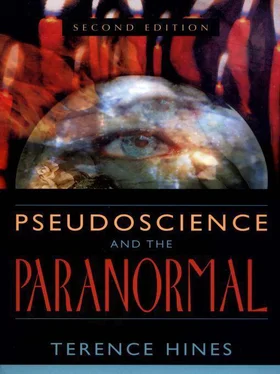But, of course, Kathryn Kuhlman didn’t see Mrs. Sullivan as she lay in her bed, crippled and dying. Nor did the thousands of people who “saw with their own eyes” that Mrs. Sullivan had been blessed with what appeared to be a miraculous cure. Since faith healers almost never follow up on the cases they claim to have cured, it is easy to understand why both members of the audience and the healers themselves can become convinced that their cures are real. Psychologically, the situation is little different from that of cold readers convinced they can foretell the future (see chap. 2). Their failures don’t return, so they see only their successes.
Nolen (1974) followed up many cases of “cures” by faith healers and found no miracles. This has been the universal result when faith healers’ “cures” are carefully investigated. Many people, if asked during or immediately after a healing session, will report that their pain has gone away or at least lessened. But, when asked about it again later, they will admit their pain has returned. This temporary reduction of pain that is so commonly reported is due to excitement-induced release of endorphins.
Testimonials are a second, related factor that falsely convinces people of the reality of faith healing—or of the effectiveness of any number of quack remedies and cures. People who genuinely believe that they have been cured by a faith healer or a quack are most effective at convincing others. The situation is similar to that of eyewitness testimony for UFOs. As was noted in chapters 7 and 8, the one piece of “evidence” that proponents of the extraterrestrial origin of UFOs find most convincing is the testimony of eyewitnesses. As was also seen in those chapters, such eyewitness testimony is highly unreliable. The same applies to testimonials about cures. One can find testimonials attesting to the effectiveness of almost anything. In the early part of this century, before government regulation of advertising claims for medicines, it was common for manufacturers to claim that their particular brand of “snake oil” would cure “consumption,” as tuberculosis was known then. They would provide genuine and sincere testimonials from people who had actually used their medicine and felt themselves to be cured. These people would later die of tuberculosis because the remedies were, in fact, worthless (Young 1967). This is illustrated by the poster shown in figure 20.
My own favorite testimonial touts a cure for cancer and cataracts so bizarre that it’s difficult to believe it’s not a joke. Time magazine, in its October 24, 1977, issue reported that Morarji Desai, then prime minister of India, attributed his vigor at age eighty-one to drinking a cup of his own urine each morning. He said “it was a cure for cancer and cataracts; he claimed to have cured his own brother of tuberculosis” with urine (p. 58). This item promptly brought another testimonial to the effectiveness of “urine therapy,” which was published in Time’s “Letters” column in the November 14, 1977, issue. One Harish Jirmoun of New Bern, North Carolina, reported that he had adopted the custom of drinking his own urine and “have faithfully maintained it for the past twelve years, gaining a sense of vigor that few of my contemporaries (I am 74) can match” (p. 10). It is safe to say that if testimonials play a major part in the come-on for a cure or therapy, the cure or therapy is almost certainly worthless. If the promoters of the therapy had actual evidence for its effectiveness, they would cite it and not have to rely on testimonials. More will be said on testimonials and urine therapy in chapter 11.
The question still remains, however, as to why people give testimonials for worthless cures and treatments. One might expect them to be better able to tell whether they have been cured than to identify the real nature of a UFO they have sighted. But the issue is not so much the ability to determine whether one’s condition has improved, but to what cause one attributes the improvement. People often mistake the cause of their improvement because they do not understand simple facts about disease. One such fact that plays into the hands of faith healers and quacks is that most diseases, even serious or terminal illnesses, show variability over time in how ill the patient feels and the severity of his symptoms. The patient with a terminal illness is ultimately going to die. But from day to day, week to week, and month to month, there can be large and irregular changes in how the patient feels and the severity of the symptoms. Sometimes the patient will feel better, other times worse, even though the overall course is downward. This is shown diagrammatically in figure 21.
Why is this variability so important? It means that, even though the overall course of a terminal illness is downward, it is possible to find two points in time, marked A and B in figure 18, between which the patient will think he has improved—he will feel better, for various reasons, even though the disease is still present and has not been cured. If the patient were to go to a faith healer at point A, he would very likely attribute his subjective improvement to the healer and give a glowing testimonial. A further point needs to be made here. When is an individual most likely to seek out some type of unorthodox treatment or cure? Unorthodox treatment is much more likely to be sought when the patient is feeling especially poor. Thus, the chances are great that, because of the variable nature of most diseases, the patient will perceive some improvement in the days following the unorthodox treatment. This has nothing to do with the treatment, but is simply due to the nature of the disease process itself. Nonetheless, the individual is quite likely to attribute the perceived improvement to the faith healer or quack. (Readers with some statistical training will recognize this effect as a type of regression to the mean.)
Two serious diseases that are extremely variable over time in the severity of their symptoms are multiple sclerosis and arthritis. Faith healers and quacks frequently claim to be able to cure these. McKhann (1982) in a review of the literature on multiple sclerosis, comments that “a striking feature of multiple sclerosis, particularly early in the course of the disease, is the degree of recovery patients can achieve during remissions” (p. 232). These remissions can last for months or years before symptoms reappear. Arthritis, a disease that often causes severe pain in a person’s joints, also shows great variation in the degree of pain the patient suffers. For years, copper bracelets have been a favorite quack cure for arthritis. In spite of the fact that the bracelets have absolutely no effect on the disease, testimonials abound, along with pseudoscientific double-talk used to promote the bracelets. Why did the patients provide the testimonials? Sufferers were much more likely to buy a bracelet when their pain was especially severe, so that ordinary measures, such as aspirin, would not be helpful. Thus, there was an excellent chance that, due to the temporally variable nature of arthritis pain, the pain would be less in the period following purchase of the bracelet. This would be incorrectly attributed to the bracelet, not to the nature of the disease.
Another important factor operates to convince people of the effectiveness of faith healing and quack cures, especially when the “cure” involves the removal or lessening of pain. This is known as the placebo effect. For decades it has been known that if a patient believes that a treatment is going to be effective at reducing pain, in about one-third of patients the treatment will actually cause a pain reduction. This occurs even though the pain is due to some actual organic process and the treatment consists of administering a totally inert substance, or placebo, such as sugar water (Melzack 1973).
Читать дальше












